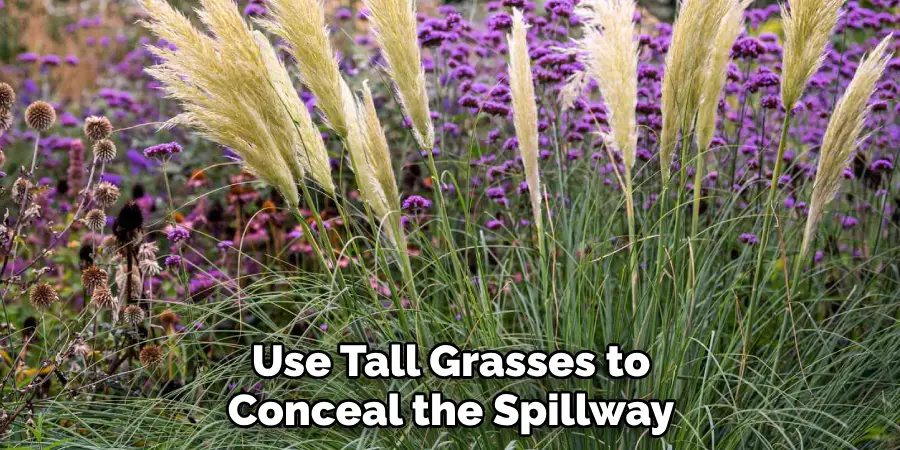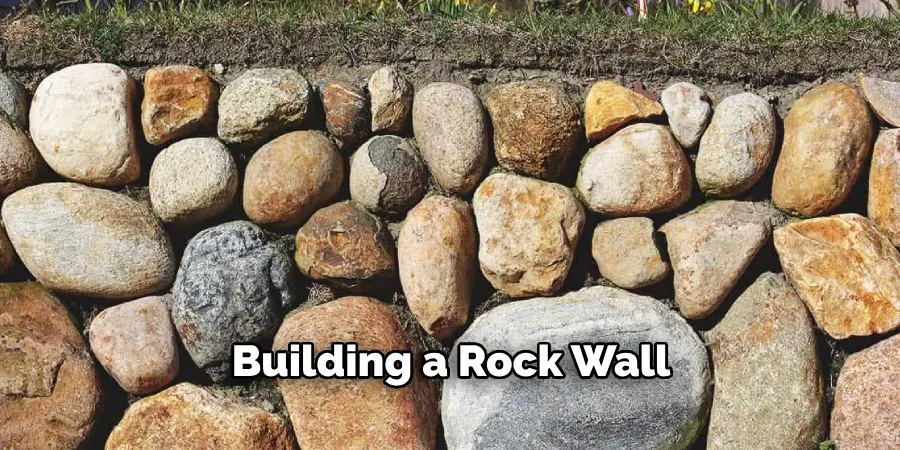If you’re a fan of outdoor water features, chances are that you have come across the popular trend of incorporating a waterfall spillway into your backyard design. These spillways not only add beauty and tranquility to any landscape but also create soothing sounds that can help drown out unwanted noise from traffic or neighbors.

However, for some homeowners, the aesthetics of these structures may need to fit in with their desired look for their outdoor space. The good news is there are ways to hide a waterfall spillway while still enjoying its benefits. In this blog post, we will discuss various techniques and ideas on how to hide a waterfall spillway so it seamlessly blends in with your landscape design.
Necessary Items
Before diving into the various ways to conceal a waterfall spillway, it’s essential to have all the items on hand for the project. These include:
- Large rocks or boulders
- Plants (such as tall grasses or shrubs)
- Landscaping fabric
- Mulch or gravel
10 Steps on How to Hide a Waterfall Spillway
Step 1: Concealing with Rocks
One of the most popular ways to hide a waterfall spillway is using large rocks or boulders. These can be placed strategically around the spillway to create a natural rock formation, making it blend in with its surroundings. Be sure to choose rocks similar in color and texture to those already in your landscape.
Step 2: Planting Tall Grasses
Another effective technique is to use tall grasses to conceal the spillway. These can be planted in front of the structure, allowing their height to block the view of the spillway from certain angles. Choose a variety that thrives in your climate and complements your existing plants.

Step 3: Creating a Rock Garden
Consider turning it into a rock garden if you have a large waterfall spillway. This involves using smaller rocks and gravel to create a layered effect, hiding the spillway while maintaining its functionality.
Step 4: Using Shrubs or Bushes
Similar to tall grasses, shrubs or bushes can also be used to hide a waterfall spillway. These can be planted in front of or around the structure, creating a natural barrier that adds depth and texture to your landscape.
Step 5: Installing Landscaping Fabric
To conceal the spillway further, consider using landscaping fabric. This can be placed over the structure and covered with mulch or gravel to create a seamless look in your garden. The material also helps to prevent weeds and erosion.
Step 6: Incorporating a Water Feature
If you want to mask a waterfall spillway’s appearance completely, consider incorporating it into a more extensive water feature. This can be done by connecting the spillway with a stream or pond, making it look like a natural part of the landscape.
Step 7: Adding Lighting
Strategic lighting can also help to hide a waterfall spillway. By placing lights around the structure, you can create shadows and highlights that draw attention away from the spillway. This is especially effective at night, creating a soft and inviting ambiance in your outdoor space.
Step 8: Building a Rock Wall
For larger waterfall spillways, building a rock wall around it can effectively hide the structure while also adding interest to your landscape. The wall can be built with complementary rocks or boulders that blend in with your existing design.

Step 9: Using Natural Elements
Take advantage of natural elements in your landscape, such as trees or shrubs, to create a natural camouflage for the waterfall spillway. This can be done by strategically planting these elements around the structure, allowing them to blend in with their surroundings.
Step 10: Incorporating Waterfall Spillways into Your Landscape Design
Lastly, when planning your landscape design, consider incorporating the waterfall spillway into it from the beginning. This allows you to create a seamless and cohesive look that integrates the structure into your outdoor space.
As you can see, there are many ways to effectively hide a waterfall spillway while enjoying its beauty and functionality. Whether using rocks, plants, or other elements, carefully plan and execute your camouflage technique for the best results. With these tips, you can create a stunning outdoor oasis that seamlessly incorporates a waterfall spillway into its design.
8 Things to Avoid When Hiding a Waterfall Spillway
While the steps outlined above provide practical ways to hide a waterfall spillway, there are also some things you should avoid to achieve the best results. These include:
1. Placing Too Many Rocks or Plants Around the Spillway
While rocks and plants are great for concealing the spillway, it’s important to do just what is necessary. Too many can make the structure look unnatural and out of place in your landscape design.
2. Not Considering Maintenance Access
Be sure to leave enough space around the spillway for maintenance access. This will make cleaning and maintaining the structure easier without disrupting the surrounding landscape.
3. Forgetting About Safety
When concealing a waterfall spillway, it’s essential to consider safety measures. Be mindful of any potential hazards, and make sure the structure is safe for children and pets.

4. Using Incompatible Materials
As mentioned earlier, when choosing rocks or plants to hide a waterfall spillway, select ones similar in color and texture to your existing landscape. Using incompatible materials can make the structure stand out rather than blend in.
5. Neglecting Drainage
Proper drainage is crucial for maintaining a healthy and functional waterfall spillway. When hiding one with rocks or plants, avoid obstructing any drainage outlets.
6. Overlooking Balance and Symmetry
Aim for balance and symmetry in your design when concealing a waterfall spillway. This will create a cohesive look that seamlessly integrates the structure into your landscape.
7. Not Considering Surrounding Views
Before finalizing your camouflage technique, consider how the spillway will look from different angles and viewpoints. This will help you create a more natural and seamless integration into your outdoor space.
8. Ignoring the Overall Aesthetic
When choosing how to hide a waterfall spillway, remember to consider the overall aesthetic of your landscape design. The goal is to create a cohesive and visually appealing look, so make sure the camouflage technique complements your existing outdoor space.
By avoiding these common mistakes, you can successfully hide a waterfall spillway and enhance the beauty of your outdoor space. With careful planning and execution, you can create a natural and seamless integration that adds depth and interest to your landscape design. So go ahead, get creative and try out different techniques until you find the perfect way to hide your waterfall spillway!
Frequently Asked Questions
Can I Use Any Rocks or Plants to Hide a Waterfall Spillway?
It’s important to select rocks and plants that are similar in color and texture to your existing landscape. This will create a more natural and seamless look. Avoid using materials that are too contrasting or incompatible with the surrounding elements.

Are There Any Other Ways to Hide a Waterfall Spillway?
Yes, in addition to the techniques mentioned above, you can also consider using artificial rocks or covers designed explicitly for hiding spillways. These options may provide a more uniform and consistent look for your camouflage technique.
How Often Should I Maintain a Hidden Waterfall Spillway?
The frequency of maintenance will depend on various factors such as climate, water quality, and the design of your waterfall spillway. It’s essential to regularly check for any debris or blockages that may affect the structure’s functionality.
How Can I Ensure Safety When Hiding a Waterfall Spillway?
When concealing a waterfall spillway, make sure to consider safety measures such as leaving enough space for maintenance access and ensuring proper drainage. It’s also important to supervise children and pets around the structure.
If you have any concerns, consult with a professional before making any changes to your landscape design. Use common sense and take necessary precautions to ensure a safe environment.
Can I Incorporate a Waterfall Spillway into My Landscape Design?
Yes, you can! It’s recommended to plan for the waterfall spillway during the initial landscape design process. This allows for a seamless and cohesive integration of the structure into your outdoor space.
However, it’s still possible to incorporate a waterfall spillway into an existing landscape design with careful planning and execution. Consult with a professional if you need assistance in this process.
Conclusion
In conclusion, hiding a waterfall spillway doesn’t have to be daunting or overwhelming. With the tips and tricks on how to hide a waterfall spillway outlined in this blog post, you now have the knowledge and tools needed to transform your backyard into a peaceful oasis.
Whether you use natural elements like rocks and plants or opt for an artificial camouflage method, the result will be a stunning and seamless addition to your outdoor space.
Don’t be afraid to get creative and think outside the box when hiding your spillway. The possibilities are endless, and the end result will indeed be worth the effort.
By implementing these techniques, you can not only enhance the beauty of your home but also add value to it in the long run. Plus, who wouldn’t want a secret hidden oasis right in their backyard? So go ahead and give it a try – your hidden waterfall awaits!
About
Outdoor Fixes is a distinguished figure in the world of Diy design, with a decade of expertise creating innovative and sustainable Diy solutions.
His professional focus lies in merging traditional craftsmanship with modern manufacturing techniques,
fostering designs that are both practical and environmentally conscious. As the author of diy,
outdoorfixes delves into the art and science of outdoorfixes-making, inspiring artisans and industry professionals alike.
Education RMIT University
(Melbourne, Australia) Associate Degree in Design (Outdoor Fixes) Focus on sustainable design, industry-driven projects,
and practical craftsmanship. Gained hands-on experience with traditional and digital manufacturing tools, such as CAD and CNC software.
Nottingham Trent University
(United Kingdom) Bachelor’s in outdoorfixes.com and Product Design (Honors) Specialized in product design with a focus on blending creativity with production
techniques. Participated in industry projects, working with companies like John Lewis and Vitsoe to gain real-world insights.
Publications and Impact
In diy, Outdoor Fixes his insights on indoor design processes, materials, and strategies for efficient production.
His writing bridges the gap between artisan knowledge and modern industry needs, making it a must-read for both budding designers and seasoned professionals.

